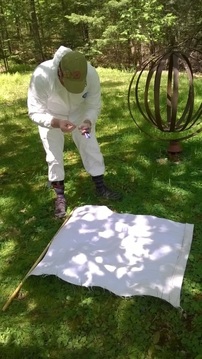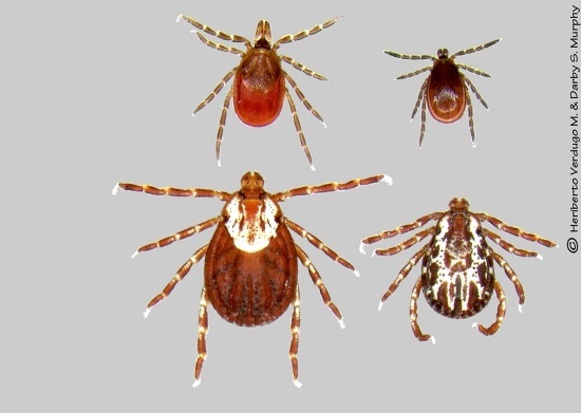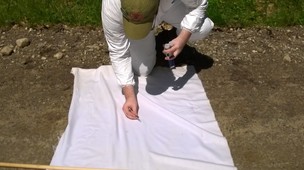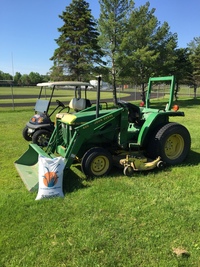News
The Maine school tick management survey results are in. Seventy percent of respondents said that they do have a concern with ticks on school property. Eight percent of
respondents said they hire a professional to apply pesticides for tick control, with number of applications ranging from two to six per year. Only eight percent of schools are using tick drags to monitor for ticks. Forty-five percent of schools are currently not performing any kind of monitoring for ticks. Twenty-four percent of respondents have modified school properties to reduce tick habitat such as keeping grass mown low, cutting shrubby undergrowth in forested margins adjacent to school properties, widening trails, or installing a 3' wide gravel or wood chip border at interface between wooded areas and mown grass. The complete results are available here.
There
are fourteen different tick species in Maine. The two most common species you
might find are the deer tick and the American dog tick (see image below). Deer
ticks are often found in wooded areas and near tree lines, while dog ticks can
be found in grassy areas such as a field. Ticks prefer a humid environment found
in shade, leaf litter, under shrubs and trees and even in the wood chips under
a swing-set. Ticks do not fly, but hitchhike on animals and people by
“questing”—holding out their front legs in readiness to attach to a person or
animal walking by. Deer ticks carry diseases such as Lyme disease, Powassan
virus, erlichiosis and babesiosis. Fortunately, disease risk posed by the
American dog tick is low in Maine. To effectively manage ticks and protect your students and staff, it is important to identify which ticks are
present, how many, and precisely where they are located on school properties.
 |
|
Reduce Tick Habitat and Shade: Ticks, deer ticks especially, thrive in shady, humid conditions. Remove leaf litter on woodland trails and at the interface of woods and play areas. Keep grass mown. Maintain and prune shrubs, trees and flower beds to reduce shade and rodent harborage. Brush-hog and weed-whack where needed. Eliminate brush piles and tall grasses around buildings.
Discourage Rodents: Keep foundations in good repair. Seal off holes in and under buildings and sheds. Seal gaps in rock walls. Mow, bush-hog, weed-whack and prune to eliminate grassy, brushy, and shrubby areas that harbor rodents. Do not allow stacks of materials (such as unused equipment, lumber, brush piles) to sit on the ground. Remove or raise them well off the ground to eliminate potential rodent harborage.
No Hitchhikers Allowed: Ticks hitchhike onto school grounds on birds, deer,
dogs and other animals. Install fencing to exclude deer from area. Adopt a ‘no
dogs’ policy. Keep trash receptacles covered, clean and well-maintained so
animals won’t come looking for food waste. Keep bird-feeders off school
grounds.
Keep People Away from Ticks: Move swing sets and sand boxes away from the
woodland edge. Use signage and barriers to keep people away from tick-infested
areas. Clear and widen woodland trails. Create a 3-foot or wider wood chip,
mulch, or gravel pathway between the edge of the lawn and woods.
Safety Precautions: Emphasize and educate
staff and families about proper personal protection such as using repellents,
wearing light-colored long sleeves and long pants, and performing regular tick
checks.
|
 Deer tick (top): female (L), male (R) and American dog tick (bottom): Female (L), male (R)
 Tick Monitoring: Sampling provides a key tool for identifying population size and hot spots for ticks in an area. The most effective and cost efficient method is tick flagging and dragging. Attach a 3’x3’ white cloth to a wooden dowel; heavy flannel or corduroy works best. Tie twine to the dowel for a handle. The flag can then be dragged over the ground and low vegetation to collect ticks. Ticks that are questing will hook onto the cloth, allowing you to collect and identify them. Keep records to document the number of each species and dates of ticks collected at each location.
Knowing which
species, how many and where ticks are present is critical to managing them and
reducing risk to people.
|
Maine School IPM Pest solutions http://www.maine.gov/dacf/php/integrated_pest_management/school/pest-solutions/index.shtml
GotPests-Ticks http://www.maine.gov/dacf/php/gotpests/bugs/ticks.htm
MMCRI- Lyme &
Vector-Borne Disease Laboratory https://mmcri.org/ns/?page_id=1090
CDC-Ticks https://www.cdc.gov/ticks/index.html
 |
|
Upcoming Workshops: (click on the link to register)
June 28, 2017 8:30am-12:00pm. Waterville Senior High
School, Waterville, ME. Register Here
July 11, 2017 8:00am-3:00pm, School Turf Workshop. Gardiner High School, Gardiner, ME. Please Register by July 6th! See Flyer for more information.
July 25, 2017 8:00am-11:00pm. Central Aroostook High
School, Mars Hill, ME. Register Here
Want to host workshop at your school? Contact Kathy
Murray, or call 287-7616 to
schedule it.
On-line Training: Learn (or refresh your knowledge) on Maine's School IPM
requirements such as notices, signage and record-keeping. Click on
either of these links: [PDF or PowerPoint Show]
Webinars. For a list of upcoming
School IPM webinars and links to on-demand recordings visit the EPA Center for
School IPM Expertise Webinar page.
|
Questions/Comments? Contact us!
Email: kathy.murray@maine.gov
Phone: 207-287-7616
Get this from a friend? Subscribe Now! Or visit maine.gov/schoolipm to subscribe.
|